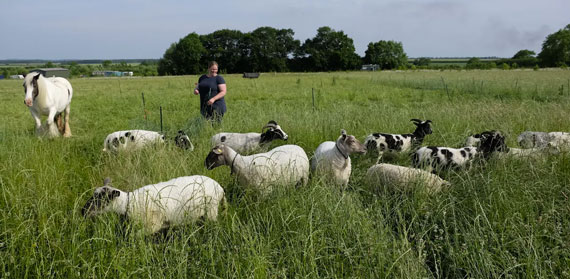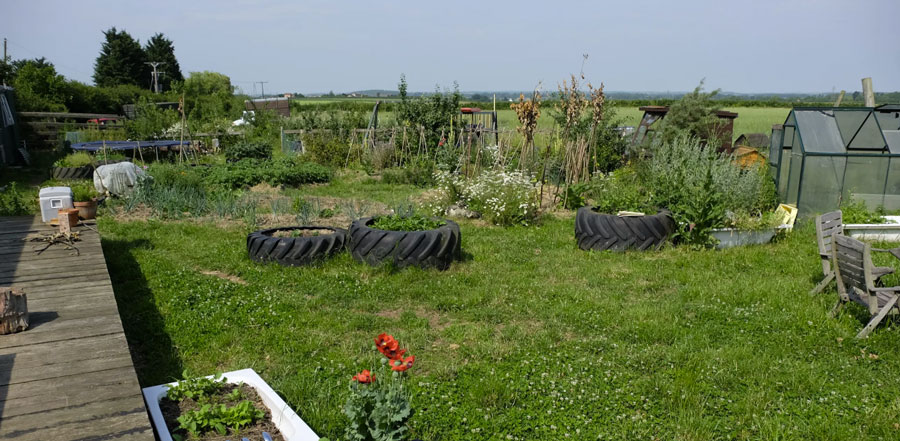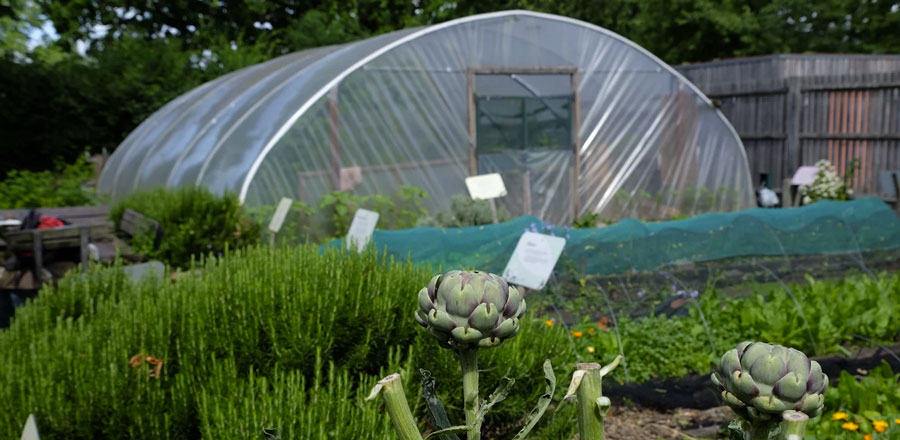21/06/2017
We visited Inkpot Farm, Hannah Thorogood’s permaculture eden in Nottinghamshire. We experienced a warm welcome and took an inspiring walk around the farm with detailed explanations on how the system is managed. Hannah introduced us to her holistic grazing system, where the pastures are more or less never cut, and the animals are moved every day to a new patch of pasture; in this way the plots are grazed only once every 3-6 months. For details on this form of management also see Allan Savory (‘holistic management’) or André Voisin (‘rational grazing’).
At Inkpot Farm we could also gain insights on the efficiency of poultry in a polygrazing system and learn about a nice trick on how to rear turkey in a stress-free manner: Hannah has transformed a motorised van to become the overnight turkey housing which is then driven from one grazing plot to the next. The turkeys get used to these rides, thus remaining fairly relaxed on their final trip to the abattoir.
We interviewed Hannah in the farm’s meeting centre that serves as an office and educational place. Permaculture design courses (PDCs) are held on the farm and based on what we saw, I am sure a course there would be a life-changing event for anyone! Finally, we walked around the garden where vegetables and fruits are grown for the family, volunteers and the students on courses alike. The garden had a piece of forest garden too with delicious raspberries and small fruit trees as well as several other edible plants. All in all it had been a very impressive, well designed and well managed farm.
22/06/2017
We drove to a farm in Gloucestershire within a very beautiful landscape and traditional buildings, well-kept pastures and large apple orchards. The farm wants to remain anonymous, therefore we can’t share more information.
23/06/2017
After taking an early train to London we went to explore how one can operationalise urban farming in UK’s capital city. We were surprised to see that the growers there had set up a network of small market gardens. They belong to the ‘Growing Communities’, a farming project that started around 20 years ago. It now consists of nine smaller, separate plots that jointly constitute a ‘patchwork farm’. Plots are located in public parks or church yards. We visited two of the plots and had the chance to interview Sophie, one of the growers who has been involved for the longest time and who is also looking after the administration of the community. The idea was to set up an urban food system, where people can grow locally and buy locally without produce or people having to travel much.
In order to assure grower succession, Growing Communities have set up a three year traineeship scheme. After successful completion the grower takes over responsibility for one plot and starts his or her own growing. This scheme works well in bringing in new people, as others move on. Marketing of produce is achieved through a veg box scheme to private consumers as well as through delivery to local bars and cafés. Plots are not used for production alone. There are perennial beds, small ponds, and less-used, undisturbed areas as well. These areas are useful to nature and support biodiversity while production serves the local community and supports food sovereignty.
The weekend that followed had been busy too: we finalised questionnaires and reflected on what we had seen. Assessments tend to be quite intensive both for the interviewer as well as to the interviewee.
Week 2 26/06/2017
Around early evening we went to visit an organic farm near Frankton, a mere 20 minutes ride away from Coventry. The first thing we saw was a herd of brown, almost small deer-like animals. It turned out later that they are a special, traditional breed of sheep that is considered endangered. We met George, the farmer and his wife in the farmhouse, a passive solar house with good insulation and whose roof was covered by solar panels that provide more energy than what the farm needs, thus providing additional income. We even saw an electric car whose batteries were actually being recharged with produced solar power! Later we had a guided tour of the farm lying within a spectacular landscape. A beautiful lake at the centre of the farm provides around 50 % of the total water needed by animals and horticulture activities.
In the vegetable garden heritage varieties are grown for seed saving, e. g. from more than 20 bean varieties. There was a 1.25 ha sized orchard with traditional varieties of apple, plum, quince and cherry. The area is grazed, so the trees have to be fenced, otherwise sheep and cattle would browse them. George showed us the agroforestry system that he planted 17 years ago, a nice sloping pasture with rows of poplars and a heaven for the cows who were kept there at that moment. Eventually we walked up to the highest point of the farm, where George explained to us the art of hedge-laying and how to grow the beautiful hedges the UK is known for. In summary, this visit showed many sustainable practices supported by a good ethos, just as at the previous farms. We had an inspiring time and it was late evening by the time we got back home.
This week, we will continue travelling east, to Canterbury and Norfolk, visiting some other projects. We will write our next post over the coming weekend, so if you are interested in our future adventures, don’t miss our post!







Comments are disabled